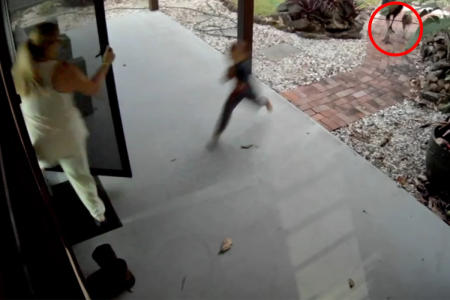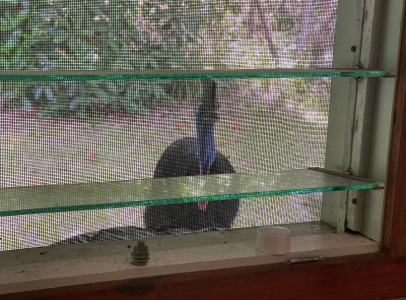One mum. One child. One charging cassowary—Could this happen on your street?
By
Maan
- Replies 0
Australia’s wildlife is known for being both beautiful and unpredictable—but sometimes, the consequences of human interaction are more serious than they seem.
What began as an ordinary day in a quiet Queensland suburb took a dangerous turn when a native species acted in a way that’s alarming experts.
What unfolded has prompted fresh warnings about how close is too close when it comes to living alongside nature.
Australia’s cassowaries may look like prehistoric relics, but when they step out of the rainforest and into suburbia, the results can be downright dangerous.
In a troubling incident captured on a home security camera at Mission Beach in North Queensland, a woman and child were seen fleeing into their home as a cassowary charged after them. What made this encounter especially concerning to experts wasn’t just the boldness of the bird—but what it reveals about human behaviour.
The Department of Environment, Science and Innovation (DETSI) confirmed the incident occurred in May and used the footage to issue another stern reminder: stop feeding cassowaries.
Dr Graham Lauridsen, a local vet who has become a reluctant expert on these birds over the past 25 years, said the problem was getting worse. People were deliberately enticing the animals for the sake of social media posts.
‘They’re getting fed more than ever before. And people are feeding them so they can get themselves a photo with a cassowary and stick it on social media,’ he said.
The clip showed not just one bird, but a male cassowary and its chick lingering outside the home long after the door had shut.
Source: Youtube/7NEWS Australia
According to Lauridsen, this behaviour is becoming increasingly common as cassowaries begin associating people with food
He warned: ‘Cassowaries can injure you if they’re stirred up enough. That can be if they’re pushing them away because you don’t want them to be near you, or if they’ve got chicks around.’
And that’s exactly what raised alarm among experts—the presence of the chick.
Lauridsen explained that parent cassowaries would bring their young to food sources, which heightens the risk for unsuspecting residents. ‘If you get between them and the chick, they’ll do you harm,’ he said.
Despite repeated warnings, the feeding continues. Rangers have installed signage and run education campaigns, but many people ignore the advice. DETSI ranger Jeff Lewis noted that while this mother and child were lucky to get inside safely, the broader issue remains unresolved.
‘Thankfully the mother and child were able to get inside to safety, but it’s an important reminder to not interfere with wildlife,’ he said.
But the danger isn’t limited to humans.
While cassowaries can pose a risk to people, the act of feeding them is doing far greater damage to the birds themselves. Lauridsen estimated that one person is injured by a cassowary each year—but countless more cassowaries are harmed as a result of being lured into towns.
‘Almost all cassowaries that have been hit by cars or attacked by dogs in Mission Beach, when we’ve done post-mortems on them, they have domestic fruits inside them,’ Lauridsen said.
‘We say in the field that a fed bird is a dead bird.’
The birds’ boldness isn’t isolated to Mission Beach. In nearby Cardwell, a 55kg cassowary was photographed peering into a home. Even those who’ve never fed a bird can find themselves on the receiving end of aggressive behaviour.
Lauridsen explained: ‘They don’t necessarily distinguish one person from another...They literally believe humans will provide them with food whenever they’re around, and unfortunately, when they don’t, they’re scary and potentially dangerous.’
Cassowaries are capable of serious injury. Each foot bears three claws, and the inner toe carries a dagger-like talon measuring up to 15 centimetres. Though fatalities are rare and typically occur in captivity, the threat remains very real. The last recorded death was in Florida in 2019.
Beyond the immediate dangers, there’s a deeper ecological concern. Cassowaries evolved over 60 million years and play a vital role in the health of Queensland’s rainforests by eating native fruits and dispersing seeds.
But when they’re fed commercial produce, that role is disrupted—and it’s the environment that suffers.
For Lauridsen and other experts, the message couldn’t be clearer: feeding cassowaries doesn’t just endanger people—it undermines an entire ecosystem.
To report dangerous cassowary behaviour, residents were encouraged to contact rangers on 1300 130 372.
It’s not just backyards where these birds are making their presence felt—bushwalkers have also found themselves face-to-beak with a cassowary in the wild.
For those who enjoy a stroll in nature or used to hike the northern trails, this clip is worth a look.
Watch how quickly a peaceful walk turned into a close call.
Source: Youtube/9 News Australia

Have you ever had a surprising run-in with native wildlife in your own backyard? Let us know your thoughts in the comments.
In another recent story, we covered a terrifying moment where a man feared for his life after a shocking wildlife encounter was caught on camera.
For older Australians living near bushland or in regional areas, these close calls serve as a reminder that our interactions with native animals can quickly take a dangerous turn.
If you’ve ever wondered just how quickly things can escalate, this one is worth a look.
Read more: ‘I thought I was dead’: Shocking wildlife encounter caught on camera
What began as an ordinary day in a quiet Queensland suburb took a dangerous turn when a native species acted in a way that’s alarming experts.
What unfolded has prompted fresh warnings about how close is too close when it comes to living alongside nature.
Australia’s cassowaries may look like prehistoric relics, but when they step out of the rainforest and into suburbia, the results can be downright dangerous.
In a troubling incident captured on a home security camera at Mission Beach in North Queensland, a woman and child were seen fleeing into their home as a cassowary charged after them. What made this encounter especially concerning to experts wasn’t just the boldness of the bird—but what it reveals about human behaviour.
The Department of Environment, Science and Innovation (DETSI) confirmed the incident occurred in May and used the footage to issue another stern reminder: stop feeding cassowaries.
Dr Graham Lauridsen, a local vet who has become a reluctant expert on these birds over the past 25 years, said the problem was getting worse. People were deliberately enticing the animals for the sake of social media posts.
‘They’re getting fed more than ever before. And people are feeding them so they can get themselves a photo with a cassowary and stick it on social media,’ he said.
The clip showed not just one bird, but a male cassowary and its chick lingering outside the home long after the door had shut.
Source: Youtube/7NEWS Australia
According to Lauridsen, this behaviour is becoming increasingly common as cassowaries begin associating people with food
He warned: ‘Cassowaries can injure you if they’re stirred up enough. That can be if they’re pushing them away because you don’t want them to be near you, or if they’ve got chicks around.’
And that’s exactly what raised alarm among experts—the presence of the chick.
Lauridsen explained that parent cassowaries would bring their young to food sources, which heightens the risk for unsuspecting residents. ‘If you get between them and the chick, they’ll do you harm,’ he said.
Despite repeated warnings, the feeding continues. Rangers have installed signage and run education campaigns, but many people ignore the advice. DETSI ranger Jeff Lewis noted that while this mother and child were lucky to get inside safely, the broader issue remains unresolved.
‘Thankfully the mother and child were able to get inside to safety, but it’s an important reminder to not interfere with wildlife,’ he said.
But the danger isn’t limited to humans.
While cassowaries can pose a risk to people, the act of feeding them is doing far greater damage to the birds themselves. Lauridsen estimated that one person is injured by a cassowary each year—but countless more cassowaries are harmed as a result of being lured into towns.
‘Almost all cassowaries that have been hit by cars or attacked by dogs in Mission Beach, when we’ve done post-mortems on them, they have domestic fruits inside them,’ Lauridsen said.
‘We say in the field that a fed bird is a dead bird.’
The birds’ boldness isn’t isolated to Mission Beach. In nearby Cardwell, a 55kg cassowary was photographed peering into a home. Even those who’ve never fed a bird can find themselves on the receiving end of aggressive behaviour.
Lauridsen explained: ‘They don’t necessarily distinguish one person from another...They literally believe humans will provide them with food whenever they’re around, and unfortunately, when they don’t, they’re scary and potentially dangerous.’
Cassowaries are capable of serious injury. Each foot bears three claws, and the inner toe carries a dagger-like talon measuring up to 15 centimetres. Though fatalities are rare and typically occur in captivity, the threat remains very real. The last recorded death was in Florida in 2019.
Beyond the immediate dangers, there’s a deeper ecological concern. Cassowaries evolved over 60 million years and play a vital role in the health of Queensland’s rainforests by eating native fruits and dispersing seeds.
But when they’re fed commercial produce, that role is disrupted—and it’s the environment that suffers.
For Lauridsen and other experts, the message couldn’t be clearer: feeding cassowaries doesn’t just endanger people—it undermines an entire ecosystem.
To report dangerous cassowary behaviour, residents were encouraged to contact rangers on 1300 130 372.
It’s not just backyards where these birds are making their presence felt—bushwalkers have also found themselves face-to-beak with a cassowary in the wild.
For those who enjoy a stroll in nature or used to hike the northern trails, this clip is worth a look.
Watch how quickly a peaceful walk turned into a close call.
Source: Youtube/9 News Australia
Key Takeaways
- A woman and child were chased by a cassowary at Mission Beach after the bird, with its chick, approached their home expecting food.
- Experts warned that feeding cassowaries encourages aggressive behaviour and increases risks to both people and birds.
- Cassowaries lured into towns often suffer fatal injuries, and many found dead have domestic fruits in their stomachs.
- Feeding cassowaries also disrupts their ecological role in the rainforest, with long-term impacts on the environment.
Have you ever had a surprising run-in with native wildlife in your own backyard? Let us know your thoughts in the comments.
In another recent story, we covered a terrifying moment where a man feared for his life after a shocking wildlife encounter was caught on camera.
For older Australians living near bushland or in regional areas, these close calls serve as a reminder that our interactions with native animals can quickly take a dangerous turn.
If you’ve ever wondered just how quickly things can escalate, this one is worth a look.
Read more: ‘I thought I was dead’: Shocking wildlife encounter caught on camera








